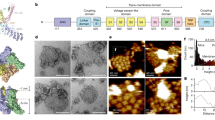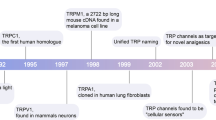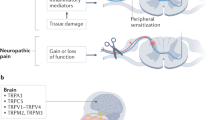Abstract
Transient receptor potential (TRP) channels are polymodal signal detectors that respond to a wide range of physical and chemical stimuli. Elucidating how these channels integrate and convert physiological signals into channel opening is essential to understanding how they regulate cell excitability under normal and pathophysiological conditions. Here we exploit pharmacological probes (a peptide toxin and small vanilloid agonists) to determine structures of two activated states of the capsaicin receptor, TRPV1. A domain (consisting of transmembrane segments 1–4) that moves during activation of voltage-gated channels remains stationary in TRPV1, highlighting differences in gating mechanisms for these structurally related channel superfamilies. TRPV1 opening is associated with major structural rearrangements in the outer pore, including the pore helix and selectivity filter, as well as pronounced dilation of a hydrophobic constriction at the lower gate, suggesting a dual gating mechanism. Allosteric coupling between upper and lower gates may account for rich physiological modulation exhibited by TRPV1 and other TRP channels.
This is a preview of subscription content, access via your institution
Access options
Subscribe to this journal
Receive 51 print issues and online access
$199.00 per year
only $3.90 per issue
Buy this article
- Purchase on Springer Link
- Instant access to full article PDF
Prices may be subject to local taxes which are calculated during checkout






Similar content being viewed by others
Accession codes
Accessions
Electron Microscopy Data Bank
Protein Data Bank
Data deposits
3D cryo-EM density maps of TRPV1 complexes without low-pass filter and amplitude modification have been deposited in the Electron Microscopy Data Bank under the accession numbers EMD-5776 (TRPV1–RTX/DkTx) and EMD-5777 (TRPV1–capsaicin). The coordinates of atomic models of TRPV1 in these two states have been deposited in the Protein Data Bank under the accession numbers 3J5Q and 3J5R.
References
Basbaum, A. I., Bautista, D. M., Scherrer, G. & Julius, D. Cellular and molecular mechanisms of pain. Cell 139, 267–284 (2009)
Baconguis, I. & Gouaux, E. Structural plasticity and dynamic selectivity of acid-sensing ion channel-spider toxin complexes. Nature 489, 400–405 (2012)
Hansen, S. B., Tao, X. & MacKinnon, R. Structural basis of PIP2 activation of the classical inward rectifier K+ channel Kir2.2. Nature 477, 495–498 (2011)
Hattori, M. & Gouaux, E. Molecular mechanism of ATP binding and ion channel activation in P2X receptors. Nature 485, 207–212 (2012)
Whorton, M. R. & MacKinnon, R. X-ray structure of the mammalian GIRK2–βγ G-protein complex. Nature 498, 190–197 (2013)
Bohlen, C. J. & Julius, D. Receptor-targeting mechanisms of pain-causing toxins: how ow? Toxicon 60, 254–264 (2012)
Vriens, J., Appendino, G. & Nilius, B. Pharmacology of vanilloid transient receptor potential cation channels. Mol. Pharmacol. 75, 1262–1279 (2009)
Liao, M., Cao, E., Julius, D. & Cheng, Y. Structure of the TRPV1 ion channel determined by electron cryo-microscopy. Nature http://dx.doi.org/10.1038/nature12823 (this issue)
Catterall, W. A. Ion channel voltage sensors: structure, function, and pathophysiology. Neuron 67, 915–928 (2010)
Long, S. B., Campbell, E. B. & Mackinnon, R. Voltage sensor of Kv1.2: structural basis of electromechanical coupling. Science 309, 903–908 (2005)
Swartz, K. J. Sensing voltage across lipid membranes. Nature 456, 891–897 (2008)
Zhu, S., Darbon, H., Dyason, K., Verdonck, F. & Tytgat, J. Evolutionary origin of inhibitor cystine knot peptides. FASEB J. 17, 1765–1767 (2003)
Phillips, L. R. et al. Voltage-sensor activation with a tarantula toxin as cargo. Nature 436, 857–860 (2005)
Swartz, K. J. & MacKinnon, R. Hanatoxin modifies the gating of a voltage-dependent K+ channel through multiple binding sites. Neuron 18, 665–673 (1997)
Bohlen, C. J. et al. A bivalent tarantula toxin activates the capsaicin receptor, TRPV1, by targeting the outer pore domain. Cell 141, 834–845 (2010)
Siemens, J. et al. Spider toxins activate the capsaicin receptor to produce inflammatory pain. Nature 444, 208–212 (2006)
Grandl, J. et al. Temperature-induced opening of TRPV1 ion channel is stabilized by the pore domain. Nature Neurosci. 13, 708–714 (2010)
Myers, B. R., Bohlen, C. J. & Julius, D. A yeast genetic screen reveals a critical role for the pore helix domain in TRP channel gating. Neuron 58, 362–373 (2008)
Yang, F., Cui, Y., Wang, K. & Zheng, J. Thermosensitive TRP channel pore turret is part of the temperature activation pathway. Proc. Natl Acad. Sci. USA 107, 7083–7088 (2010)
Zhou, Y., Morais-Cabral, J. H., Kaufman, A. & MacKinnon, R. Chemistry of ion coordination and hydration revealed by a K+ channel–Fab complex at 2.0 Å resolution. Nature 414, 43–48 (2001)
Scheres, S. H. & Chen, S. Prevention of overfitting in cryo-EM structure determination. Nature Methods 9, 853–854 (2012)
Chou, M. Z., Mtui, T., Gao, Y. D., Kohler, M. & Middleton, R. E. Resiniferatoxin binds to the capsaicin receptor (TRPV1) near the extracellular side of the S4 transmembrane domain. Biochemistry 43, 2501–2511 (2004)
Gavva, N. R. et al. Molecular determinants of vanilloid sensitivity in TRPV1. J. Biol. Chem. 279, 20283–20295 (2004)
Jordt, S. E. & Julius, D. Molecular basis for species-specific sensitivity to “hot” chili peppers. Cell 108, 421–430 (2002)
Phillips, E., Reeve, A., Bevan, S. & McIntyre, P. Identification of species-specific determinants of the action of the antagonist capsazepine and the agonist PPAHV on TRPV1. J. Biol. Chem. 279, 17165–17172 (2004)
Szallasi, A., Blumberg, P. M., Annicelli, L. L., Krause, J. E. & Cortright, D. N. The cloned rat vanilloid receptor VR1 mediates both R-type binding and C-type calcium response in dorsal root ganglion neurons. Mol. Pharmacol. 56, 581–587 (1999)
Chung, M. K., Guler, A. D. & Caterina, M. J. TRPV1 shows dynamic ionic selectivity during agonist stimulation. Nature Neurosci. 11, 555–564 (2008)
Jordt, S. E., Tominaga, M. & Julius, D. Acid potentiation of the capsaicin receptor determined by a key extracellular site. Proc. Natl Acad. Sci. USA 97, 8134–8139 (2000)
Kim, S. E., Patapoutian, A. & Grandl, J. Single residues in the outer pore of TRPV1 and TRPV3 have temperature-dependent conformations. PLoS ONE 8, e59593 (2013)
Ryu, S., Liu, B., Yao, J., Fu, Q. & Qin, F. Uncoupling proton activation of vanilloid receptor TRPV1. J. Neurosci. 27, 12797–12807 (2007)
Yeh, B. I., Kim, Y. K., Jabbar, W. & Huang, C. L. Conformational changes of pore helix coupled to gating of TRPV5 by protons. EMBO J. 24, 3224–3234 (2005)
Bernèche, S. & Roux, B. A gate in the selectivity filter of potassium channels. Structure 13, 591–600 (2005)
Cuello, L. G., Jogini, V., Cortes, D. M. & Perozo, E. Structural mechanism of C-type inactivation in K+ channels. Nature 466, 203–208 (2010)
Hoshi, T. & Armstrong, C. M. C-type inactivation of voltage-gated K+ channels: pore constriction or dilation? J. Gen. Physiol. 141, 151–160 (2013)
Hui, K., Liu, B. & Qin, F. Capsaicin activation of the pain receptor, VR1: multiple open states from both partial and full binding. Biophys. J. 84, 2957–2968 (2003)
Liu, B., Hui, K. & Qin, F. Thermodynamics of heat activation of single capsaicin ion channels VR1. Biophys. J. 85, 2988–3006 (2003)
Tominaga, M. et al. The cloned capsaicin receptor integrates multiple pain-producing stimuli. Neuron 21, 531–543 (1998)
Jiang, Y. et al. The open pore conformation of potassium channels. Nature 417, 523–526 (2002)
Latorre, R., Zaelzer, C. & Brauchi, S. Structure–functional intimacies of transient receptor potential channels. Q. Rev. Biophys. 42, 201–246 (2009)
Dai, J. et al. TRPV4-pathy, a novel channelopathy affecting diverse systems. J. Hum. Genet. 55, 400–402 (2010)
Lin, Z. et al. Exome sequencing reveals mutations in TRPV3 as a cause of Olmsted syndrome. Am. J. Hum. Genet. 90, 558–564 (2012)
Latorre, R., Vargas, G., Orta, G. & Brauchi, S. in TRP Ion Channel Function in Sensory Transduction and Cellular Signaling Cascades Frontiers in Neuroscience (eds Liedtke, W. B. & Heller, S. ). (2007)
Matta, J. A. & Ahern, G. P. Voltage is a partial activator of rat thermosensitive TRP channels. J. Physiol. (Lond.) 585, 469–482 (2007)
Nilius, B. et al. Gating of TRP channels: a voltage connection? J. Physiol. (Lond.) 567, 35–44 (2005)
Loukin, S., Su, Z., Zhou, X. & Kung, C. Forward genetic analysis reveals multiple gating mechanisms of TRPV4. J. Biol. Chem. 285, 19884–19890 (2010)
Cao, E., Cordero-Morales, J. F., Liu, B., Qin, F. & Julius, D. TRPV1 channels are intrinsically heat sensitive and negatively regulated by phosphoinositide lipids. Neuron 77, 667–679 (2013)
van der Stelt, M. & Di Marzo, V. Endovanilloids. Putative endogenous ligands of transient receptor potential vanilloid 1 channels. Eur. J. Biochem. 271, 1827–1834 (2004)
Brauchi, S., Orta, G., Salazar, M., Rosenmann, E. & Latorre, R. A hot-sensing cold receptor: C-terminal domain determines thermosensation in transient receptor potential channels. J. Neurosci. 26, 4835–4840 (2006)
Papakosta, M. et al. The chimeric approach reveals that differences in the TRPV1 pore domain determine species-specific sensitivity to block of heat activation. J. Biol. Chem. 286, 39663–39672 (2011)
Yao, J., Liu, B. & Qin, F. Modular thermal sensors in temperature-gated transient receptor potential (TRP) channels. Proc. Natl Acad. Sci. USA 108, 11109–11114 (2011)
Scheres, S. H. RELION: implementation of a Bayesian approach to cryo-EM structure determination. J. Struct. Biol. 180, 519–530 (2012)
Pettersen, E. F. et al. UCSF Chimera–a visualization system for exploratory research and analysis. J. Comput. Chem. 25, 1605–1612 (2004)
Emsley, P. & Cowtan, K. Coot: model-building tools for molecular graphics. Acta Crystallogr. D 60, 2126–2132 (2004)
Emsley, P., Lohkamp, B., Scott, W. G. & Cowtan, K. Features and development of Coot. Acta Crystallogr. D 66, 486–501 (2010)
Smart, O. S., Neduvelil, J. G., Wang, X., Wallace, B. A. & Sansom, M. S. HOLE: a program for the analysis of the pore dimensions of ion channel structural models. J. Mol. Graph. 14, 354–360,–376 (1996)
Takahashi, H. et al. Solution structure of hanatoxin1, a gating modifier of voltage-dependent K+ channels: common surface features of gating modifier toxins. J. Mol. Biol. 297, 771–780 (2000)
Acknowledgements
We thank X. Li for assistant in data acquisition using TF30 Polara and K2 Summit camera, and J.P Armache, C. Bohlen, J. Cordero-Morales and J. Osteen for discussion and reading of the manuscript. This work was supported by grants from the National Institutes of Health (R01GM098672 and S10RR026814 to Y.C. and R01NS065071 and R01NS047723 to D. J.), the National Science Foundation (DBI-0960271 to D. Agard and Y.C.) and the University of California, San Francisco Program for Breakthrough Biomedical Research (Y.C.). E.C. was a fellow of the Damon Runyon Cancer Research Foundation.
Author information
Authors and Affiliations
Contributions
All authors designed experiments. E.C. expressed and purified all protein samples used in this work and performed all functional studies. M.L. carried out all cryo-EM experiments, including data acquisition and processing. E.C. built the atomic model on the basis of cryo-EM maps. All authors analysed data and wrote the manuscript.
Corresponding authors
Ethics declarations
Competing interests
The authors declare no competing financial interests.
Extended data figures and tables
Extended Data Figure 1 Cryo-EM of TRPV1 in complex with RTX and DkTx.
a, b, Fourier transform (a) of a representative image (b). c, Two dimensional (2D) class averages of cryo-EM particles. d, Enlarged view of three representative 2D class averages. Arrows indicate DkTx densities near the channel pore. e, Gold-standard FSC curve (red) of the final 3D reconstruction, marked with the resolutions that correspond to FSC = 0.5 and 0.143. The FSC curve between the final map and that calculated from the atomic model is shown in blue. f, Euler angle distribution of all particles used for calculating the final 3D reconstruction. The sizes of balls represent the number of particles. The accuracy of rotation is 5.213°, as reported by RELION.
Extended Data Figure 2 3D reconstruction of TRPV1–RTX/DkTx complexes filtered at 6 Å resolution.
a–d, Four different views of the 3D reconstruction low-pass filtered at 6 Å and amplified by a temperature factor of −100 Å2, fitted with de novo atomic model of TRPV1–RTX/DkTx complex (toxin is shown in magenta) built as described in Methods. e, f, Two views of the 3D reconstruction displayed at two different isosurface levels (high in yellow and low in grey). At the low isosurface level, the belt-shaped density of amphipols is visible with a thickness of ∼30 Å. DkTx-related densities are also clearly visible, including the linker peptide that connects the toxin’s two inhibitor cysteine knot (ICK) moieties, as noted.
Extended Data Figure 3 Cryo-EM of TRPV1 in complex with capsaicin.
a, b, Fourier transform (a) of a representative image (b). c, 2D class averages of cryo-EM particles. d, Enlarged view of three representative 2D class averages. e, Gold-standard FSC curve (red) of the final 3D reconstruction, marked with the resolutions that correspond to FSC = 0.5 and 0.143. The FSC curve between the final map and that calculated from the atomic model is shown in blue. f, Euler angle distribution of all particles used for calculating the final 3D reconstruction. The sizes of balls represent the number of particles. The accuracy of rotation is 4.989°, as reported by RELION.
Extended Data Figure 4 3D reconstruction of TRPV1–capsaicin complex low-pass filtered at 6 Å resolution.
a–d, Four different views of the 3D reconstruction low-pass filtered at 6 Å and amplified by a temperature factor of −100 Å2, fitted with de novo atomic model of TRPV1–capsaicin complex built as described in Methods. e, f, Two views of the 3D reconstruction displayed at two different isosurface levels (high in yellow and low in grey). At the low isosurface level, the belt-shaped density of amphipols is visible with a thickness of ∼30 Å.
Extended Data Figure 5 3D reconstruction of TRPV1–RTX/DkTx complex low-pass filtered at 3.8 Å resolution.
a–d, Four different views of the 3D reconstruction low-pass filtered at 3.8 Å with a temperature factor of −100 Å2, fitted with de novo atomic model of TRPV1–RTX/DkTx complex (toxin is shown in magenta and indicated by arrows) built as described in Methods.
Extended Data Figure 6 3D reconstruction of TRPV1–capsaicin complex low-pass filtered at 4.2 Å resolution.
a–d, Four different views of the 3D reconstruction low-pass filtered to 4.2 Å with a temperature factor of −150 Å2, fitted with de novo atomic model of TRPV1–capsaicin complex built as described in Methods.
Extended Data Figure 7 Observed densities in vanilloid pocket.
a, Non-protein associated densities in the region adjacent to S3–S4 transmembrane helices observed in 3D density maps of the apo TRPV1 structure (blue, 3.4 Å, −100 Å2) or TRPV1 in complex with RTX/DkTx (red, 3.8 Å, −150 Å2) or capsaicin (yellow, 3.9 Å, −150 Å2), as indicated. b, Density of bound capsaicin (blue) viewed from the side (left) and top-down (that is, from the extracellular face; right). Density is also observed in the apo-channel structure (purple), possibly representing an endogenous lipid or other small hydrophobic molecule. All maps were low-pass filtered to 4.5 Å with a temperature factor of −200 Å2, normalized and displayed at the same sigma level (8σ).
Extended Data Figure 8 Structural details of the TRPV1 pore with and without ligands.
a–c, Density maps for pore region for two diagonally opposed monomers superimposed onto their atomic models (top). Distances between specific side-chain atoms along the pore are also indicated (bottom). d, Superimposed top-down view of apo and capsaicin-bound TRPV1 outer pore regions (orange and green, respectively). e, Density map of selectivity filter in the capsaicin-bound TRPV1 structure. The distance between carbonyl oxygens of diagonally opposed G643 residues (4.6 Å) does not differ from that of the apo structure (4.6 Å).
Extended Data Figure 9 S1–S4 as a stationary domain.
a, Superimposition of apo and RTX/DkTx-bound TRPV1 structures (orange and blue, respectively) from top-down view. S1–S4 domain (outlined in dashed box) shows near-complete overlap. b, Same comparison for apo and capsaicin-bound channel structures (orange and green, respectively). c, d, Superimposition of transmembrane core of apo versus RTX/DkTx- or capsaicin-bound TRPV1 structures (orange, blue and green, respectively). Dashed box denotes region highlighted in Fig. 6.
Extended Data Figure 10 Dual gate model for TRPV1 activation.
a, Pore helix and upper half of S5 helix are in close proximity and appear to be physically coupled, representing a potential mechanisms for allosteric coupling between upper and lower gates. Several residues on both helices are rendered as ball-and-stick to highlight close apposition. b, Downward tilt of pore helix away from the central pore is associated with movement of the S5 helix in RTX/DkTx structure (left). This structural arrangement is not observed in capsaicin-bound structure (right). c, Model depicting two gate mechanism of TRPV1 activation. Two main constriction points at the selectivity filter (1) and lower gate (2) block ion permeation in the apo, closed state (top left). Some pharmacological agents (for example, protons or spider toxins; gold hexagon) target the outer pore region of the channel to open or stabilize the conductive conformation of the selectivity filter (top right). Arrow denotes proposed coupling between the pore helix and S5. Small vanilloid ligands (for example, RTX and capsaicin; red ellipse) bind within a hydrophobic pocket formed by the S3–S4 helices, the S4–S5 linker and the pore module, eliciting conformational changes that expand the lower gate (bottom left). Arrows indicate proposed coupling between S4–S5 helix, S6 and TRP domain. Full expansion of the ion permeation pathway and ion conduction is achieved when both upper and lower gates are opened (bottom right). Pharmacological and mutagenesis data suggest that these gates are allosterically coupled.
Rights and permissions
About this article
Cite this article
Cao, E., Liao, M., Cheng, Y. et al. TRPV1 structures in distinct conformations reveal activation mechanisms. Nature 504, 113–118 (2013). https://doi.org/10.1038/nature12823
Received:
Accepted:
Published:
Issue Date:
DOI: https://doi.org/10.1038/nature12823
This article is cited by
-
Thermal gradient ring for analysis of temperature-dependent behaviors involving TRP channels in mice
The Journal of Physiological Sciences (2024)
-
Relation between flexibility and intrinsically disorder regions in thermosensitive TRP channels reveal allosteric effects
European Biophysics Journal (2024)
-
The application and development of electron microscopy for three-dimensional reconstruction in life science: a review
Cell and Tissue Research (2024)
-
Tetherless Optical Neuromodulation: Wavelength from Orange-red to Mid-infrared
Neuroscience Bulletin (2024)
-
Bortezomib-induced neuropathy is in part mediated by the sensitization of TRPV1 channels
Communications Biology (2023)
Comments
By submitting a comment you agree to abide by our Terms and Community Guidelines. If you find something abusive or that does not comply with our terms or guidelines please flag it as inappropriate.



